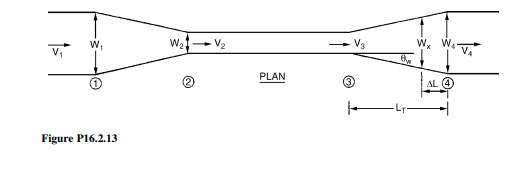solution
solution.
Analyze the culvert that you design in problem 16.2.13. The streambed elevation at the upstream end of the culvert is 1000 ft above mean sea level. Will this culvert have inlet or outlet control for the design discharge? Perform a water surface profile analysis of the culvert and transition. 16.2.15 Determine the dimensions for a culvert and gradual transition needed for a 3-m wide rectangular flood control channel at a slope of 0.001 m/m. The culvert length is 30.5 m and is to convey 8.5 m3 /s. Consider a freeboard Ă°y1
ĂÂ y4ĂĹž 0:35 m. Refer to problem 16.2.13 for further definitions. Perform a water surface profile analysis of the culvert.
Save your time - order a paper!
Get your paper written from scratch within the tight deadline. Our service is a reliable solution to all your troubles. Place an order on any task and we will take care of it. You wonât have to worry about the quality and deadlines
Order Paper Nowproblem 16.2.13~~~~~~~~~~~~~~~~~~~~~~~~~~~~
ĂÂ
Determine the dimensions of a reinforced concrete box culvert that is to be placed under a roadway, and the gradual transition needed for a 15-ft wide rectangular flood control channel at a slope of 0.0001 ft. Transition structures are used to transition flow from an open channel to a culvert and then transition flow from the downstream of the culvert back to the channel. Gradual transitions are used when the flow is subcritical throughout the culvert. Refer to Figure P16.2.13. The culvert has a length of 150 ft and is to convey a design discharge of 135 cfs. Use a ManningââŹâ˘s n of 0.02. Straight line transitions are to be used so the expansion and contraction coefficients,Ce andCc, are respectively, 0.5 and 0.3. Assume that section 1 defines the flood-control channel just before the contraction upstream of the culvert and section 4 defines the flood-control channel after the expansion downstream of the culvert. Sections 2 and 3 are located at the upstream and downstream ends of the culvert. The headloss in the contraction is CcĂ°V2 2 =2g
Ă V2 1 =2gĂĹž and the headloss in the expansion is CeĂ°V2 3 =2g
Ă V2 4 =2gĂĹž. The transition lengths (LT) are specified using a 4.5:1 flare so that LT ĂÂź 4:5Ă°W4
Ă W3ĂĹž=2 and LT ĂÂź 4:5Ă°W1
ĂÂ W2ĂĹž=2, where W is the widths at the respective sections. Choose y3
Ă 1:1yc to have a subcritical depth. One important aspect of the culvert and transition design is to make sure that the backwater effect Ă°y1
ĂÂ y4ĂĹž does not exceed a preferred or required amount (freeboard). For the purposes of this problem, that amount is 1 ft.

ĂÂ
"Looking for a Similar Assignment? Get Expert Help at an Amazing Discount!"

